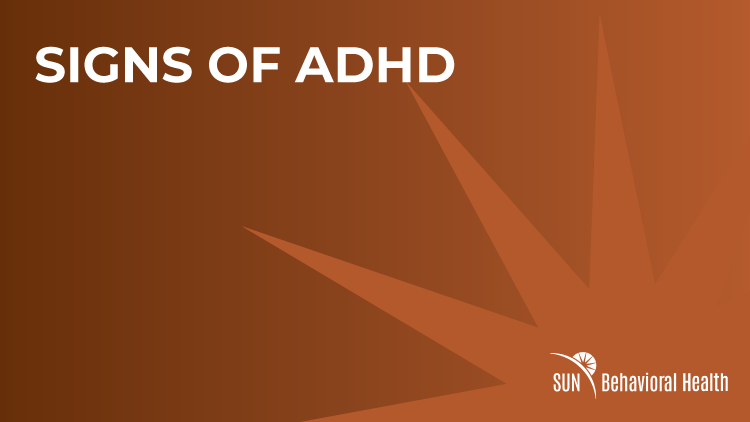Menu
close
24 Hour Crisis Care
Services

The APA defines Attention Deficit Hyperactive Disorder, or ADHD, as a “behavioral condition that makes focusing on everyday requests and routines challenging.” ADHD affects 12.8% of children living in Ohio, with 7.7% of these children on medication for ADHD according to the CDC. While children are primarily diagnosed with ADHD, adults can continue to exhibit signs of ADHD well into adulthood.
ADHD can look very different depending on the type of ADHD, age, and gender. There are three main types of ADHD diagnosed in childhood: Combined type, Impulsive/Hyperactive Type, and Inattentive/Distractible type. The Combined type is the most commonly diagnosed type of ADHD and is characterized by hyperactive and impulsive behaviors in addition to inattention and distractibility. The Impulsive/Hyperactive type is the least commonly diagnosed and is characterized by impulsive and hyperactive behaviors without distractibility and inattention. The Inattentive/Distractible type predominately is characterized by inattention and distractibility without hyperactivity. A meta-analysis by Willcutt EG. Neurotherapeutics found that “inattentive type of ADHD was the most common subtype in all samples, with the exception of pre-school children, in whom predominantly hyperactive-impulsive type was the most common.”
ADHD can have different symptoms depending on age. Children diagnosed with ADHD can experience fewer symptoms as they age, but new symptoms can appear as well. Adults with ADHD report having difficulty with emotional regulation and can become easily flustered or explosive. ADHD may cause sleep disorder in adults and children.
While ADHD is found three times more in boys than in girls, this could be due to the presentation of ADHD symptoms looking differently based on gender. Commonly, girls with ADHD have the Inattentive/Distractible type, which can be harder to diagnose because it is not as disruptive. The number of girls with ADHD might actually be higher than we think.
Individuals with Inattentive / Distractible type experience difficulty sustaining attention to tasks and remembering details. Every person diagnosed with ADHD may experience different symptoms, but these are common signs of this type of ADHD:
Individuals with Hyperactivity/Impulsivity type experience restlessness, sudden urges, and doing things without thinking. While everyone with this type of ADHD may exhibit different symptoms, these are the common signs of ADHD Hyperactivity/Impulsivity type:
While medication is prescribed to more than half of children diagnosed with ADHD in Ohio, non-invasive treatment, such as talk therapy, has become successful and more prevalent in helping individuals with ADHD. The following are many effective therapy interventions for treating ADHD:
There are plenty of skills and tools that children and adults can practice to effectively manage ADHD on their own. The following is a list of coping skills that have shown success in managing ADHD:
Most people with ADHD are diagnosed as a child, so managing ADHD effectively is a team effort. Changing behavior is easier when there is consistency. The following are some tips for parents to help their children successful manage ADHD:
If you believe you are your child are experiencing signs of ADHD, SUN Behavioral Columbus is here to help. Open 24 hours and 7 days a week, SUN Behavioral Columbus has onsite treatment and counselors as well as connections to behavioral resources in the community to help you. Navigating mental health crisis or treatment can be challenging, and we are here to make the process easier for you and your family.
Treatment for ADHD may be provided via a partial hospitalization program (PHP) or an intensive outpatient program (IOP). PHP includes five group therapy sessions per day, five days per week. The PHP groups use a cognitive behavioral therapy (CBT) approach. PHP offers coping skills training and a Wellness Recovery Action Plan (WRAP), which is an evidence-based system to help people understand and apply wellness techniques for the purpose of relapse prevention. The IOP includes three group sessions per day, five days per week. Key components of the IOP include stress management, life skills development, mindfulness, cognitive behavioral therapy, and yoga and physical wellness strategies. There are also outpatient programs tailored for children with ADHD. These treatment approaches will help you or your loved one gain new skills to better cope with ADHD.
Here at SUN Behavioral Columbus, we believe in empowering our patients to be the expert in their life. This includes being able to identify their own needs and learning how to overcome obstacles. To learn more about how we can help, call 614-706-2786.

Skip the emergency room and come to SUN for all of your behavioral health and substance use disorder needs
For a medical emergency, including a drug or medication overdose, call 911 immediately.